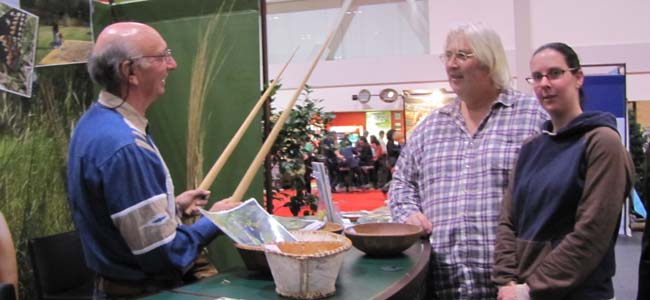Wild rice tasty….but not dry!

By Maurice Switzer
TORONTO – It might not have been as flashy as the $75,000 casting pond, or the young woman who was sculpting animal carvings out of white cedar logs with her electric chainsaw, but the display presented by the Anishinabek/Ontario Resource Management Council Show attracted a fair share of the estimated 100.000 people who visited the 67th annual Toronto Sportsmen’s Show.
Jeff Beaver estimated that 300-400 people stopped at his display of the four-month life cycle of wild rice, which the Alderville First Nation citizen has been working to restore in four Kawartha-area lakes.
“I started this work in 1989,” says Beaver, who worked in the warden’s service for 14 years for Parks Canada and currently serves as a Southeast Regional representative on the A/ORMC. The council was established in the fall of 2000 to improve communications between Anishinabek Nation member communities and Ontario’s Ministry of Natural Resources, which provided some of its Sportsmen’s show display space for A/ORMC use..
A staple of First Nations diets for thousands of years, wild rice – “Manomin”, or “Gift from the Creator” – has been ravaged by invasive species like Carp , as well as cottagers pulling it out by the roots because they think they’re removing weeds from swimming areas. There is no longer any wild rice growing in Rice Lake, on the south shore of which is located Beaver’s home community of Alderville.
“It’s great for filtering water, makes good fish habitat and wild goose nesting, and provides food for muskrats, beaver, and moose” he says, in addition to its nutritional value. Booth visitors grab brochures that tell them wild rice has more protein and fibre than white rice, but fewer calories. Beaver’s personal favourite wild rice dishes are puddings and duck or wild goose soup.
He has to keep a sharp eye on his display of wooden bowls of the only Native Canadian cereal.
“Someone decided to sample some grains of dry rice. They said ‘I thought this was like snacks,’ Beaver grins. “It went down like porcupine quills!”
Beaver’s restoration and education work includes video presentations at schools and to various interested groups. He was supported at the Sportsmen’s Show by Kristina Hubert and Janine McLeod, biologists with Alderville’s Black Oak Savanna tallgrass heritage project, Alderville council member and community historian Dave Mowatt, and Jon Averill, who works with the Aboriginal Policy Branch at the MNR’s Peterborough offices.
The A/ORMC presence included a display of Wampum Belts exchanged at the Treaty of Niagara Congress 250 years ago this July. The Treaty of Niagara marked the beginning of the treaty relationship between the Crown and First Nations, which permitted the peaceful settlement of the lands that were to become Canada. The display was presented by Union of Ontario Indians communications director Maurice Switzer.


